Red Ants ( Myrmica ).

Photo by Tom Nitti.
These ants are found in most parts of mainland Britain and most people know when they have been stung by a myrmicine ant; it is like being pricked with a red hot needle, much like a nettle sting, only more painful. It doesn't matter how many times I've been stung by "red ants", it still hurts and you never become immune to it. The sting of a red ant is not barbed, unlike a bees, which dies once it has used its sting. Ants are more closely related to wasps, who also have a barbless sting, so like the wasp, a Myrmicine ant can sting many times and not die in the process of doing so; unlike the bee, who leaves her sting in her victim. Myrmicine ants are mostly; but not always, red.
The most common are Myrmica rubra and Myrmica ruginodis. When I was in my early teens, I would often go up to the hills in East Cheshire, pick up a piece of stone, only to find a mass of little red ants who would immediately attack my fingers instead of retreating with their brood as other ants do. These ants are great for keeping in an ant-farm as long as you remember to beware of their sting. They will eat all kinds of things; but do need lots of insect prey due to their aggressive nature. It is much easier to collect workers and brood i.e.eggs, lavae and pupa, than to try and find a queen ant. I would only suggest getting a queen when you have successfully kept ants for a couple of years. It is just as easy restocking an ant-farm with fresh ants and/or brood as needed. Never destroy an ants nest by trying to dig up all the ants; as would you like it if a giant destroyed your home??
Myrmica scabrinodis.
Photos of wild M. scabrinodis showing a queen and workers, taken by Tom Nitti.
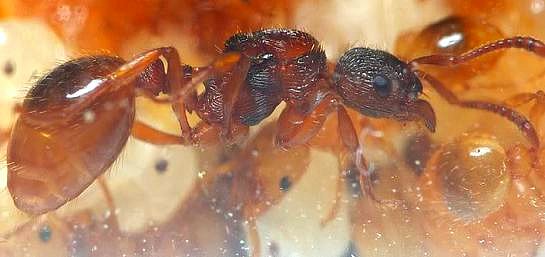
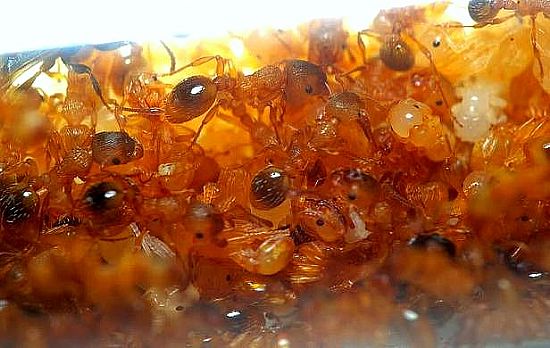
Looking very similar to other red Myrmica species found in Britain, this ant is most attractive when viewed in close up, as these photos by Tom Nitti show of a queen, workers and pupae. Note that many of the pupae will soon become callow ants as they near the adult stage .
Myrmica rubra investigate.
This lovely photo of a couple of Myrmica rubra workers using their antennae to gently explore the finger above them, while balancing on what I was told is a water holder used for birds (as I thought it looked like a gooseberry), was taken by a friend of mine. My thanks go to Tim Keppens who lives in Belgium for this rather unusual and interesting photo close up, which came very close to winning an award in the National Geographic magazine.
Tim told me that just 5 seconds after taking this photo, he had several ants biting and stinging his finger. So they may appear gentle, but beware when getting too close up and personal to ants, or they might just turn out to be giant killers. It just goes to show how ants are very inquisitive little creatures, and have no fear of things bigger than them.
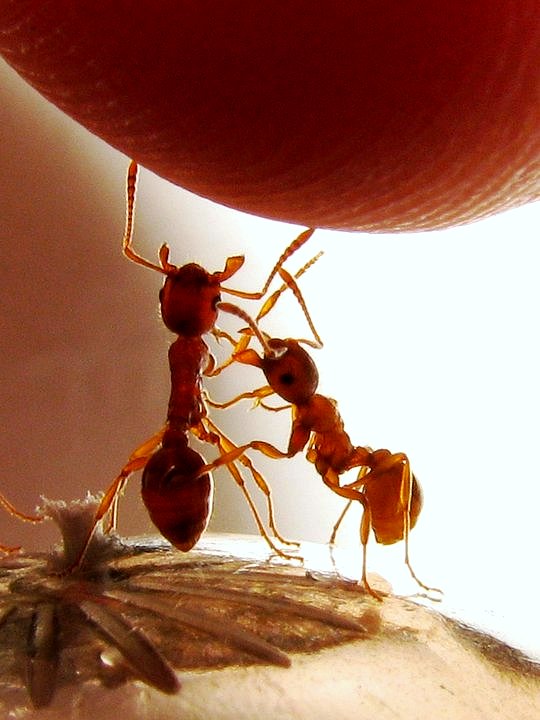
Here we have two remarkable macro photos of M. rubra taken by a very gifted photographer, Brian Valentine who lives in Worthing, just a few miles away from me in West Sussex on the south coast of England. The first shows a rubra worker drinking sweet sap exuded by cornflowers, probably where aphids have been feeding and have caused a wound on the flower bud? The second photo shows a worker carrying home a woodlouse meal. Woodlice are plentiful in my own garden, and although ants don't touch them normally, they will take and eat injured or dead ones which are easy pickings.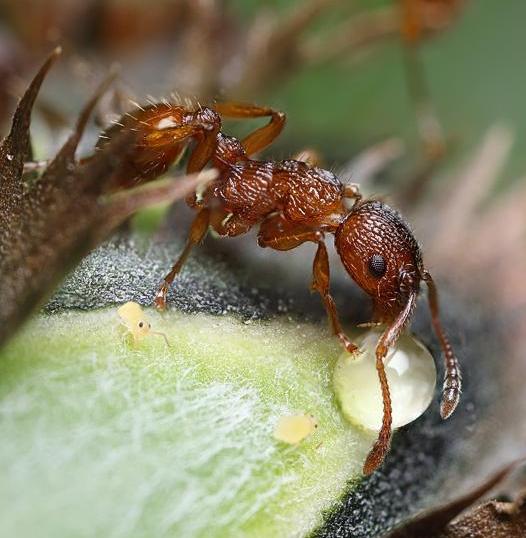
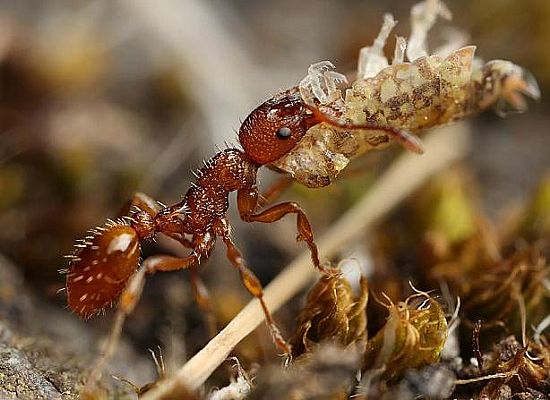
Ant Castes (kinds of ants).
Queens
During mid to late summer, ants are found in most nests which have wings. These are virgin queens and their male consorts. Some ants only have 1 queen per nest, while some will have many. Young queens can mate in the nest; but more often will go off on a mating flight. It is a sight to see hundreds of winged ants on a summers evening; though my wife complains they get in her hair and crawl down her neck. The winged queens mate with as many males as can catch them; this they must do quickly, before hungry birds eat them. Once they have filled their sperm sac, they now have the task of either (1) returning to the home nest; if the nest will take more than one queen, or (2) [and this is more usual],beginning a nest of their own.
Once on the ground, the newly fertilized queen tears off her wings, as they are no longer needed, and digs her way into a small chamber where she can now lay a small batch of eggs. As these hatch into larvae, she feeds them on what food she has from her now re-absorbed wing muscles. These larvae hatch very quickly, are very small due to the low food supply, and become tiny workers called 'minims'. Once she has a few daughters to do the nest duties, the queen can now settle down to the more permanent duty of being an egg laying mother. This is the only thing she will do for the rest of her life; which can be from 10 to 14 years in the wild, up to 16 or17 in some species, especially in captivity; or even longer than this in extreme cases, as a Lasius niger queen holds the record for the longest lived ant reaching the age of 32 years I believe?
Drones ( Males).
Male ants
At the same time as the young virgin queens start to appear in an established nest, or sometime slightly earlier, winged male ants can be seen. Males come from unfertilized eggs which are often the first eggs laid in late winter, or very early in spring. These males, or Drones, are produced from eggs laid either by the queen or her infertile workers; but more usually it is the queen that does so, laying eggs when the internal nest temperature prevents their being fertilized.
The main task in the life of the poor old male (or Princes as they are sometimes referred to, the winged females being called "Princesses") is to mate with the winged females; either their sisters from the parent nest, or more often with females from other nests of the same species nearby. Surprisingly winged ants can, and often do, fly several miles in search of mates, as prevailing winds help carry them far from their home nesting site!
Once he has mated, the males often dies shortly afterward. Any male which attempts to re-enter the nest of his birth is soon attacked and killed by his worker sisters, often ending up as food for them and the larvae. Thousands of winged ants go forth on the annual mating flight, and most will end up as food for hungry birds, spiders and even other ant colonies wherever they may land and be found by foraging scouts; but enough will make it and mate to ensure the survival of the species so that many more new nests are founded.
A typical good sized garden, park or field will often be found to have several nests of varying sizes and different species. Male ants are born for one thing and one thing only, to mate. They perform no other task or nest duty other than fertilizing the virgin queens, so once their job is done, they simply become a liability to the colony and are surplus to requirements, as they are no longer needed after their job of mating is done. The males may not live longer than 6 or 7 months, which makes their life short compared to a queen which may live for over 10 years and even longer; but they live on in the colony by leaving their genetic code behind for any future generations of their kind.
Ant Colony Workforce.
Workers + Soldiers
In any ant nest, the vast majority of ants are workers. Usually they are much smaller than the queen / queens. They perform all tasks both in, and out of the nest; such as finding food, digging tunnels, keeping the nest clean and raising the brood that will provide the colony with more workers/soldiers. Depending on the species, some workers are bigger than their sisters and may act as guards or even wage war on other ants. Most ant nests usually contain a few hundred workers, while larger nests will contain several thousand or even hundreds of thousands. A typical nest of the wood-ant, Formica rufa, can have from 10,000 up to 250,000; depending on queen numbers and food supply.
Some ants will fight to the death to defend their home, while others will beat a hasty retreat. This seems to be the tactic used by Formica fusca when their nest is invaded by the so-called "slave making ant", Formica sanguinea. It is believed that the slave maker actually raids the fusca nest for food; but not all the captive brood is eaten, the rest being raised into adult ants that perform the exact same duties they would have done in their own nest. As workers do the most, it is best to use these in an ant-farm set up to observe their behaviour; but please do make sure you give them food +water if you want them to survive. Rather than keep a queen, you can always try to put a few larvae/pupa in your nest from the same species as your captive workers; then watch your nurse ants clean and feed 'the babies'. Worker ants, being under developed females, often do lay eggs. These eggs are called "trophic"eggs and are mainly used as food. If they are allowed to hatch and grow, they will only produce males as the eggs are infertile owing to the fact that workers, even though they possess ovaries; do not have a sperm sac as does a queen! The workers are also incapable of mating, although I have seen male ants try to copulate with them when males are kept with workers under captive conditions, so they probably do the same in a wild nest.
Brood rearing.
Ants eggs are sticky when laid, so they adhere together in a mass that make it easier for the nurse ants to move the eggs around. They are constantly licked clean by their attendent nurses, as the danger of mould, fungus or mite infestation is a constant threat in the nest environment. The eggs split open after a time and hatch into small larvae. Now the nurses really have their work cut out, as it is in the larval stage that the developing "baby"ants need lots of food and care. As a human baby needs its mothers milk to help it grow; so the ant larvae need to have a liquid diet. This is provided by the nurses getting food from workers who have been out hunting, storing it in their crop, and then regurgitating it back for the larva as a nutritious kind of 'soup'. Larvae go through various stages of growth and development, which ends when they pupate.
Pupa can be bare, or cocooned, depending on the particular ant species. Either form develops in what seems like a state of suspended animation; as while larvae move their heads a lot, pupae do not move at all. However, while the pupa appears dormant, fundamental changes are taking place in the larva( worm like grub) as it grows into an adult ant. Where there was nothing about the appearence of the larvae to suggest it was an ant; the pupa has the distinct look of the adult ant; whether it be a queen, a worker or a male ant. Once the young ant tears itself from the pupal skin or cocoon, or is helped out by nurse ants, it rests for a few hours while its outer skin hardens up. It is also given a meal by its sisters, the nurses; afterwards it is then ready to assume its role in the life of the colony, be it a worker or winged sexual, or a more specialist ant such as a nurse or soldier etcetera. Depending on this, will govern the lifespan of the individual in terms of whether it lives just a few months, or several years??
Who is in Command?
A lot of people will assume that, because ant colonies are for the most part, female orientated; then the queens must be the ruling body which gives orders to the nest inhabitants. This is far from the truth. In fact, the social structure within the nest works from the oldest workers down through the nest to the rest of the colony. The queens are little more than "captive"egg laying mothers! I say "captive" in as much as, they can leave the colony if they want to; but to do so without their daughter workers would lead very quickly to a queens death, as they cannot survive for long alone. Safety in numbers is the key word here.
Ants do not have Prime Ministers or Generals, so just how do they know what to do? It would seem that this is where the so called "Collective Mind" comes in useful. To use an analogy, anyone who has seen "THE BORG" on the Star Trek T.V.programme will have some idea what I'm talking about ? Worker ants do whatever is required for the up-keep and smooth running of the nest. They seem to have a leaning to a female biased society and will actively cull eggs laid by the queen if too many males are likely to be born.
Older workers are more experienced at doing tasks and do all the jobs outside the nest, while younger workers with less knowledge of life do jobs like tunnelling or nursing the brood. It makes sense to send out older workers as hunter-gatherers as their armour and fighting skills are superior to that of their younger sisters; and it also means that, should the older workers be killed while foraging, then there are still plenty of younger ones back home in the nest to replace them! Eventually,the older workers die either by being killed or by natural causes, and the younger ones replace them as foragers, while in turn a new generation takes over the nest duties.
So, to give the title of "QUEEN" to the egg laying mother of an ant nest, is not really politically correct. Perhaps we should just call her "MUM"?? After all, that's what a queen ant really is to all of her worker daughters and drone sons.
Major or Minor?
There seems to be a new process of evolution taking place with the species} Myrmica ruginodis. It has developed into 2 sub-species. [1] M.ruginodis microgyna, and [2] M. rug.macrogyna.
The 1st (Microgyna), has many small queens (up to 100 per colony) who mate in, or very near, the nest. The queens are only a bit bigger than their workers, and the nests swarm by using the "budding"system.
The 2nd (Macrogyna), has less queens (usually less than 20 with about 12 being average); but they are a lot bigger than the worker caste and are capable of starting their own, new nest, after mating. Nest numbers vary in both types, according to how many queens there are, plus environment and food sources.
Microgyna seems to be the mutation, and is not as widespread as Macrogyna; which has crossed the Irish sea to Eire.
The words speak for themselves}- Micro = small,Gyna = female (Queen) or MACRO = large.
The 2 sub-species do not appear to be inter-breeding; and so are forming their own, seperate ant societies which may eventually evolve into two entirely distinct species?

